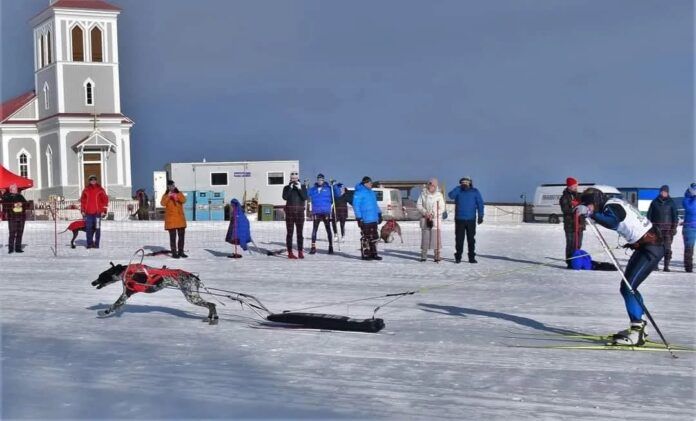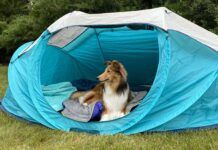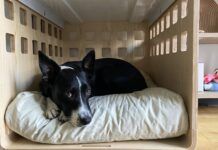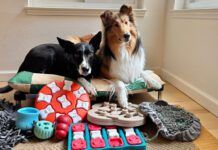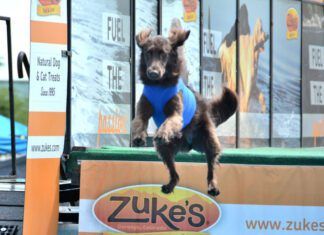If you’ve ever dreamed of your dog pulling you while you run, ski, or bike, there are dog sports for all of those activities. For winter sport lovers, skijoring is an excellent way to get out and enjoy the snow with dogs.
Whether you’re a seasoned cross-country skier looking to bring your dog along for the ride or you’ve never skied before, here’s how to get involved in skijoring.
What is Skijoring?
Skijoring is similar to canicross, where a dog is attached to you by a bungee line connected to a special pulling harness. For both skijoring and canicross, your dog’s bungee line will be attached to a special canicross or joring belt that you wear.
Skijoring uses the skate style of Nordic or cross-country skiing, as opposed to the classic Nordic style. If you’re a downhill skier, you’ll need different gear (and different skills!) to try out skijoring.
How To Get Involved in Skijoring
First, you’ll need to ensure your dog is suitable for skijoring. Many northern breeds like Samoyeds, Huskies, and Malamutes are great for pulling-focused sports because they were bred to pull. However, other breeds like Border Collies, German Shorthaired Pointers, and mixed breeds also often enjoy the sport, so breed isn’t a barrier to entry. As long as your dog likes to run, they can be taught to skijor.
The biggest consideration before getting your dog involved in skijoring is if they’re old enough and healthy enough to handle pulling. Many people wait until dogs are between one and a half and two years old before introducing pulling to ensure their joints are fully developed before putting stress on them.
Once you’ve decided if your dog is a good candidate for skijoring, you’ll want to start building your skijoring community and learning more about the sport.
“I think the best way to get involved is both joining a club for skiing and training your skiing skills and joining a skijoring club to give your dog experience,” says Jessica Häggqvis, a skijoring competitor based in Sweden.
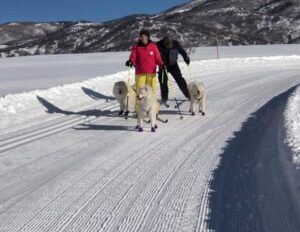
Melissa Whittinslow, a recreational skijorer based in Colorado who runs Samoyeds, agrees that group and club meetups are great ways to learn about skijoring. She says that you’d likely be able to borrow gear to try and take advantage of trained dogs who can help teach your dog the game at meetups. Look on Facebook for local groups and clubs centered around mushing and other winter dog sports.
If you live in a state with lots of ski resorts, you may also be able to take skate skiing lessons at a Nordic center without your dog. “Most Nordic centers will offer lessons for humans to learn foundational skills and techniques,” says Devin Walker, a skijoring enthusiast with a background in Nordic racing based in Colorado. “Skijoring isn’t a big sport in the United States like it is in Europe, but if you poke around social media, you can often find groups near you.”
Walker says that she recommends people learn to skate ski on their own without their dog first, and that skijoring is much more fun for the dog and handler if the human is comfortable on skis.
Walker mentions that Nordic skis don’t have edges, which can take a while to get the hang of. She recommends taking lessons or learning from an experienced friend on your own before you introduce your dog to the sport.
Though it’s important to learn how to skate ski to participate in skijoring, you don’t have to be a perfect skier to enjoy dog skiing. “I’ve been at world championships with competitors/skiers who are just standing straight not doing anything so there’s many ways to participate,” says Häggqvist.
How To Train Your Dog to Skijor
Teaching your dog commands on the ground first is a great entry level point to skijoring. Once you have a suitable harness, a belt, and a line, you can start teaching skijoring commands without skis, which is essentially canicross.
“Many people who skijor also do canicross, as it allows for year-round training,” says Walker, who skijors and runs canicross with her rescue dog, Ruby.
Whittinslow also started out in skijoring by teaching her dogs commands while running canicross. “I was a long-distance runner when I was younger, so this came easier for me,” she says.
Some of the basic commands dogs need to know for skijoring are:
- Line out: Put tension in the line before starting
- Hike: Go faster
- Gee: Right
- Haw: Left
- Woah: Slow down
- On by: Move past a distraction
When introducing your dog to skiing, Walker recommends starting slow and getting them used to skis, snow, and the sounds and motions of the skis on snow. “Sensitive dogs may need some time to get used to the sounds,” she says. “Be positive, be excited, and praise your dog frequently!”
Dog Skijoring Gear
In addition to skate skis, poles, and other human cross-country skiing gear, there’s some dog-specific gear you’ll need before you can start skijoring with dogs.
“You want to start with a bungee/tug line that is long enough for your dog to get out from your skis,” says Walker. “The human needs a belt, and the dog needs a pulling-specific harness. I strongly suggest having a quick-release mechanism attached to the belt for skijoring, for added safety.”
If your dog has long or curly hair or is sensitive to the cold, dog boots can also be a good idea to have on your gear list. You’ll avoid snowballs in their fur and will be able to stay out longer if your dog’s paws are sensitive. Häggqvis says that whether or not you’ll need booties depends on the dog and the snow you’re working with. Some snow can be sharp and icy, so keeping booties on hand is a good idea in case you run into less-than-stellar conditions.
If your dog doesn’t like booties, you can also use Musher’s Secret or another paw wax or paw balm to protect your pup’s feet from the cold.
Can You Compete in Dog Skijoring?
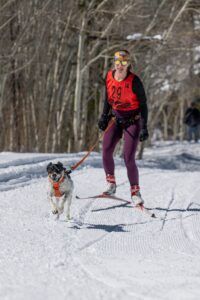
You can compete in skijoring, but you’ll need to do a bit of work to find local races in the United States. According to Walker, the best bet for finding races is by joining local mushing and sled dog clubs who put on events. For example, in Colorado, Colorado Mountain Mushers and Rocky Mountain Sled Dog Club often host winter race events with skijoring classes. You can also watch kicksledding and bigger sled teams during these events.
Should I Try Skijoring With My Dog?
All the current skijoring teams we chatted with recommended trying skijoring out with someone who has experience. “Having another dog to run with can really make a big difference in helping a new dog understand the game,” says Walker. “And it’s always helpful to get a second opinion on the fit of your dog’s harness when just getting started. Skijoring is so much fun, and it’s a great way to stay active with your dog in the winter, I’d highly recommend trying it out!”
“I know getting into skijoring can seem scary or not practical when you don’t know how to ski, but don’t let this stop you,” says Whittinslow. She says that the best thing about skijoring is that you don’t have to be a stellar skier to participate. “I love just being outdoors with my dogs working and learning together.”


